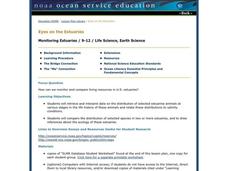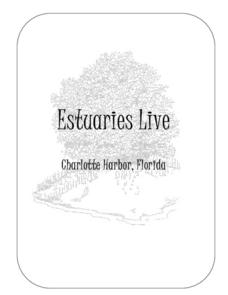Curated OER
Water in the Environment
In this water in the environment worksheet, students match 10 terms related to water to their definitions. They identify 10 sentences as true or false related to groundwater, layering and landfills. They fill in the blanks for 2...
Curated OER
Ocean World - Interactive On-line Quiz - Coral Reefs
In this coral learning exercise, students answer 9 multiple choice questions about coral and coral reefs using an interactive on-line format.
Curated OER
Unit 5 - Food
Students study the biodiversity existing in the Amazon rainforest. In this Amazon biodiversity lesson, students study diagrams, maps, and information about the biodiversity in the Amazon.
Curated OER
Cells Behaving Good or Bad
Students study cellular behavior. For this cell lesson students identify and develop a research question, collect data and formulate conclusions.
Curated OER
Eyes on the Estuaries
Young scholars study estuaries and compare several ones in the U.S. In this estuary lesson plan students interpret data and compare the distribution of different species.
Curated OER
Do You Have Change?
Students analyze data and complete a worksheet about land use change in a coastal region. In this land use lesson, students discuss events that cause land use changes in coastal areas. They construct a change table to summarize data on...
Curated OER
Coral Bleaching
High schoolers examine the relationship between corals and zooxanthellae, identify stresses to corals, and explain coral bleaching. In this sea life lesson students predict the effects of increased temperatures on coral reefs.
Curated OER
Biomes: Freshwater & Seawater
Students observe organisms behavior and adaptations. In this biomes lesson students conduct fieldwork to determine water quality and answer questions about the differences between different habitats.
Curated OER
Locating the Salt Front
Students use Hudson River salinity data to create a line
graph that shows the location of the salt front, and use math
skills to explore how this location varies over time. They use the graph to estimate the location of the salt front...
Curated OER
Brine Shrimp 1: Hatching Brine Shrimp
Learners review their prior knowledge on brine shrimp. In groups, they raise a group of brine shrimp and design an artificial environment in which they can live. They change the conditions of the environment to see how the shrimp react...
Curated OER
Underwater Picture of the Hudson River Estuary
Students identify important aspects of water quality such as slainity and turbidity. They test two of the water quality parameters and determine the quality of the water. In addition, they construct two sets of graphs based on data...
Curated OER
The Physiological Tolerance of Two Species of Protozoans
High schoolers examine the differences in pH tolerance between the two species and relate these differences to their respective niches.
Curated OER
Jeannette
Pupils develop hypothesis about what might happen when salt water is frozen. In groups, they freeze ice samples with different salt concentrations. They use the internet to research the situation of the Jeannette to discover their answer.
Curated OER
Beaches of the Delaware Estuary
Learners examine estuaries in Delaware. They, in groups, gather samples of water to find organisms and identify them.
Curated OER
Bauxite: More Than A Small Town
Students identify the mineral bauxite and its impact on the community and the world. They use the Internet to research the mineral and its uses. They draw a picture depicting the uses of bauxite.
Curated OER
Estuaries Live Charlotte Harbor, Florida
Students reorganize sentence strips into paragraphs to learn about seagrasses. They learn vocabulary and facts about sea grasses using the paragraphs once they are reconstructed. They continue their study with a number of associated...
Curated OER
Understanding Estuaries
Young scholars work together to develop their own estuarine ecosystem in an aquarium. They observe the aquarium daily and record them in a notebook. They discuss the different interactions they see with the class.
Curated OER
Phragmites australis: Invasive Plant Species
Young scholars research and investigate invasive species, with specific focus on the exotic plant Phargmites australis and its impact on Piermont Marsh near the community of Piermont, New York.
Curated OER
Exploring the Aral and Salton Seas
Students investigate the environments of the Aral and Salton Seas. They use images taken from the space shuttle, the U2 spy planes, and remote sensing satellites to learn more about what is happening in each region. Students discuss the...
Curated OER
Ecology
Pupils examine the relationship between the environment and those that have to live in it. They discover that we are responsible for our environment and understand the consequences of its neglect.
Curated OER
Layering of Water
Students examine what happens when different types of water meet. In groups, they participate in an activity in which they combine different percentages of salt, fresh and brackish water and record their observations. They let the...
Curated OER
To Drink or not to Drink
Seventh graders discuss water quality, water availability and water resources and how water is used in the world around them. They view a video on water quality then test for pH, temperature and dissolved oxygen to indicate water quality.
Curated OER
Currents: Bad for Divers; Good for Corals
Students describe, compare, and contrast major forces that drive ocean currents. They discuss the general effects of topography on current velocity. They discuss how velocity affects the ability
Curated OER
This Old Tubeworm
Students explain the process and significance of chemosynthesis. They develop their own graphic based on data of a biological community. They estimate the age of a given species as well.

























